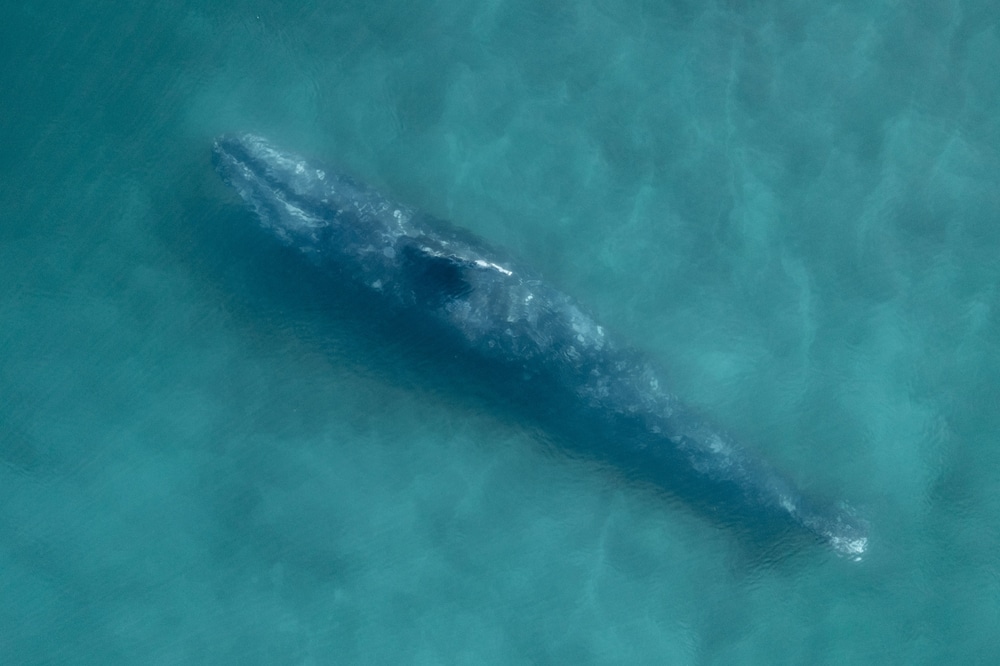Gray whales have been veering off their normal routes along the West Coast and swimming under the Golden Gate Bridge into San Francisco Bay in unprecedented numbers.
Using thousands of photographs of distinctive markings on the whales’ backs to identify them, marine scientists have confirmed that at least 71 different gray whales—and possibly 84 or more—swam into the bay between 2018 and 2023, with some staying for more than two months, raising their risk of being hit by cargo ships, oil tankers or other large vessels.
From 2010 to 2017, only about one or two of the giant marine mammals came into the bay every year. Last year, however, there were at least 16, and in 2019 there were at least 21.
“We think it has a lot to do with the fact that the whales haven’t been getting enough food,” said Bill Keener, a biologist with The Marine Mammal Center, a non-profit group in Sausalito. “They may be weak and resting for a while, or they looking for an alternative food source.”
Some are malnourished, he said.
From 2019 to 2023, 22 gray whales were found dead in or near San Francisco Bay, according to data from The Marine Mammal Center, the California Academy of Sciences and public agencies. Of those, 14 died from unknown causes. Researchers performed studies, called necropsies, on nine of the whales. Six died from malnourishment. Three died from a collision with a ship.
Over the past four years, dead gray whales have been found inside San Francisco Bay off Angel Island, and near Richmond, Rodeo, Hercules, San Leandro, Mountain View, the Port of Oakland, Tiburon, the Berkeley Marina and Martinez.
“They aren’t just near the Golden Gate,” said Keener, who said a slower speed limit for big ships in the bay may be needed. “They are way into the bay, past Angel Island, down to Treasure Island. There’s a lot of ship traffic there.”
Wayward whales have inspired public interest for years.
One lost humpback, nicknamed Humphrey, gained national attention in 1985 and became the subject of children’s books, songs and a movie—drawing crowds of onlookers with binoculars—when he swam into the bay. Humphrey meandered up the Delta to sloughs 25 miles south of Sacramento, staying 26 days before finally returning to the Pacific Ocean as researchers played whale songs from speakers off boats to lure him west.
In 2007, a mother humpback and her calf, nicknamed “Delta and Dawn,” swam into the bay and ventured as far up the Delta as Rio Vista before scientists in boats coaxed them back into the open ocean 10 days later.
The pattern comes amid a big drop in the gray whale numbers off the Pacific Coast in recent years.
Once hunted by whaling ships in the 1800s for their oil until there were only about 1,000 or 2,000 individuals left, gray whales were protected in 1972 when President Nixon signed the Marine Mammal Protection Act. The last whaling company in the United States, the Del Monte Fishing Company, operated at Point Molate in Richmond. It made Kal-Kan dog food out of whales that its crews shot with mechanized harpoon cannons. The company closed in December 1971 as the law was about to take effect.
After whaling was banned in the U.S., numbers of gray whales increased. By 1994, after they reached a healthy population, the Clinton administration removed them from the Endangered Species Act list in what is still considered one of the nation’s major wildlife success stories.
Their population jumped to 27,000 by 2016, according to estimates from NOAA, the National Oceanic and Atmospheric Administration. But then it fell by at least one third by 2022. Hundreds of malnourished whales began to wash up on beaches in Alaska, Washington, Oregon, California and Mexico. Nobody knew why.
Researchers said the die-off from 2018 to 2023, which NOAA called an “unusual mortality event,” was likely due to a shortage of food in the Arctic linked to changes in the amount of sea ice, wind patterns and other factors. Whales eat 3,000 pounds or more of food a day, preferring small, shrimp-like crustaceans known as amphipods, along with worms and other tiny creatures that they scoop from the sea floor.
Last year, gray whale numbers began to rebound to as many as 21,000. NOAA declared an end to the “unusual mortality event” in November. Scientists are watching carefully to see if the change is temporary or permanent.
The roller coaster population—and weird detours into San Francisco Bay—could be related to climate change, or it could be part of the gray whale’s natural population fluctuations, said John Calambokidis, a research biologist with Cascadia Research, in Olympia, Washington.
One thing is clear: The gray whales coming into San Francisco Bay are heading north as part of their annual migration from Baja, Mexico where they mate and breed, and turning right under the Golden Gate Bridge instead of continuing north to Alaska where they stock up on food during the summer months.
A lot is known about the latest trend because one researcher, Josephine Slaathaug, of the Marine Mammal Center, painstakingly sorted through more than 11,000 photographs of gray whales in San Francisco Bay last year. She built a database, identifying individual whales from photos taken on whale watching boats, the shoreline, and the center’s boats. She showed the animals are most common in March and April, and stayed in the bay between 13 and 75 days.
Slaathaug, a masters student at Sonoma State University, won a prestigious fellowship in April from the National Science Foundation as she expands the study in the coming years. One key question: Will the number of gray whales in the bay go down if their food in the Arctic recovers, and the West Coast population increases?
“We don’t understand all the drivers,” she said. “We have preliminary data. But we do know that with all the ships, the bay is not a very safe place for the whales.”










